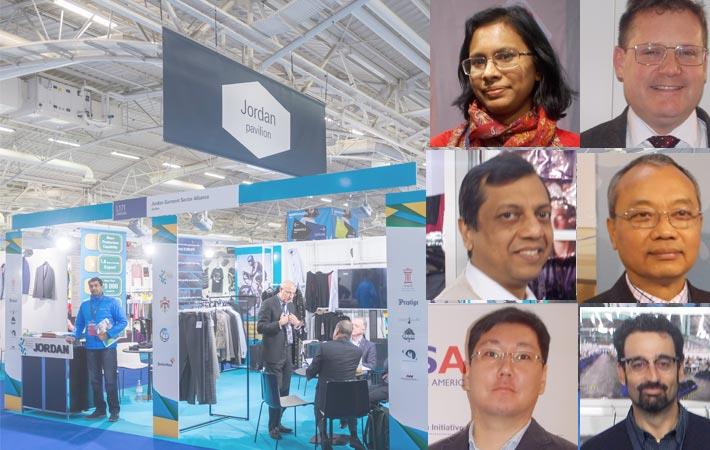Rivals make best of India-EU FTA deadlock

Negotiations for an ambitious and broad-based free trade agreement (FTA) between India and the European Union (EU) were launched in June 2007. The negotiations were the EU’s first attempt to engage a large developing country in a reciprocal bilateral trade opening exercise.
But after 12 rounds of talks, and several technical meetings and discussions, parleys came to a standstill in the summer of 2013 following a mismatch of ambitions and expectations. Discussions resumed in January 2016, but have made no headway thereafter. In the meantime, several emerging countries have seen their chance to strengthen their position in the EU market.
The Apparel Sourcing trade fair in Paris from February 11 to 14 provided a snapshot of the textile trading lanscape in Europe, particularly the European Union markets.
India was represented at the event by as many as 30 firms (31, if you also count Ethiopian subsidiary Kanoria Africa Textile). Not bad, one might say; but then, China sent a multifold of that number to Paris. As Apparel Sourcing consolidated its position as the European leading sourcing trade fair, Indian exhibitors felt that over the next few years increasing competitive pressure won’t come so much from export giant China as from the South Asian neighbours Bangladesh and Pakistan, and a number of emerging low-cost countries. Vietnam and Sri Lanka were not represented at the fair.
Garment companies from several emerging countries, supported either by the EU or other sponsors, displayed garment products at the trade fair. Among them were companies from Jordan, Kyrgyzstan and Myanmar, countries which are currently enjoying zero-duty access to the EU market. Sure, it will take some time before these countries can grab even a modest share of the large EU market. However, as long as India and EU don’t succeed agreeing on the terms of an FTA, emerging garment countries with zero-duty access to the EU market have an edge.
Asian neighbours corner India on European turf
Chinese garment exporters are well aware that their price weapon has become less sharp and that they should focus more on the other Ps of Philip Kotler’s classic marketing mix (Price, Product, Place, Promotion). Angel Ostroviecki, sales representative of the European division of the Chinese HongDou Group (12,000 workers), says his group is working on the P of Place by not only manufacturing garments in China but also in a cheaper place, Cambodia. As for the P of Promotion, a smart move of HongDou Group was the establishment in January 2018 of a sales subsidiary in Barcelona. Ostroviecki is sure that the European sales subsidiary will offer the group’s customers, like C&A, Kappahl, Billabong, a superior service compared with that of the usual independent sales agents in Europe.
If it were to depend on sales manager Sarah Ouyang of Chinese garment company Wingtas, from Xiamen (with exports of up to 500,000 pcs/month), the company’s exports will be increasingly destined for Europe. Why? “American customers order bigger quantities, but they press for lower prices. You can more easily negotiate with Europeans about prices and delivery times,” Ouyang contends. Among the European brands for which Wingtas is working are Mango, Fila, Kappa.
Meanwhile, Bangladesh has succeeded in beating all other countries, except China of course, as a global exporter of garments. The main comparative advantage of the Bangladeshi exporters is still the country’s low labour cost. In some parts of China, the monthly minimum wage for clothing workers reached $321 in 2016, nearly five times higher than the minimum wage of $68 in Bangladesh. The official minimum wage in the Bangladeshi garment industry may shortly be steeply increased .
Yet, CEO Enamul Kabir of Ensa Clothing, Dhaka (2.4 million knitted garments per year) is not afraid to predict growth for his own exports and those of Bangladesh, especially to Europe. His explanation: “The Chinese do business with their mind, we Bangladeshi think with our heart. Bangladesh is better in social compliance than China. This is important for the Europeans. By the way, did you know that seven of the ten ‘green’ garment companies in the world can be found in Bangladesh?”
Dilara Begum, commercial counsellor of the Embassy of Bangladesh in Paris agrees: “The Bangladeshi industry is indeed caring for the environment. Our country will nevertheless be a victim of climate change. Bangladesh is also caring for the workers. After the 2013 hike of wages there’ll again be a hike in 2018. In spite of that the garment industry will continue being a pillar of our country’s strongly growing economy. One thing is sure: the population of Bangladesh is very resilient.”
On othe other hand, in spite of Euratex’s (European Apparel and Textile Confederation) furious efforts to prevent Pakistan from acquiring the EU GSP+ status, Pakistan got it in December 2013. This status has been extended to the three-year period 2018–2020, which means that Pakistani textile products will continue being imported duty-free in EU.
Senior manager (innovation & marketing) Iftikhar-ul-Hassan of Masood Textile Mills Ltd, from Faisalabad, points out that Pakistani exporters like Masood enjoy several competitive advantages making the competition with India and China somewhat easier. Masood is operating an integrated plant ‘from cotton knit yarn to finished garment’. With more than 20,000 workers it’s one of the largest textile mills in South Asia. Masood is still on a growth path. Among its European customers are Puma, Celio, KIK, and among its American customers are Walmart and Levi’s. Hassan stresses that the Masood factories are WRAP and ISO 9001 certified. He boasts that the Pakistani textile and apparel industry is doing well in the field of sustainability. The government is pushing the industry to drop the use of coal as a source of energy; it wants Pakistan to rely on hydro, thermal and nuclear energy.
Another trump card of the Pakistan textiles sector is the presence of as many as five textile universities. “The largest of these five is located in our city, Faisalabad,” smiles Hassan. He also remarks that since this year Pakistan has, besides Karachi Port and Port Qasim, a third deep sea port: Gwadar Port, which is part of the ambitious Chinese Sea Belt project.
Myanmarese companies try their luck in Paris
The Dutch Centre for the Promotion of Imports from developing countries (CBI) presented eight handpicked companies from Myanmar at Apparel Sourcing. All of them were locally owned companies which aim at making a sustainable move from CMP (cutting, making, packaging) to FOB (free on board). Some of them are considered role models by their colleagues. This is especially the case of Unique HTT (winner of the national Compliance Award 2017), the highly efficient SMC Group of companies, and the sustainability-oriented knitwear manufacturer Shwe Sakar.
The SMC Group of companies is one of the largest locally-owned garment manufacturers in Myanmar. For producing outerwear, woven garments, knitwear and sportswear, SMC employs 2,340 workers in three factories. Among its customers are Inditex and C&A.
Unique HTT, a manufacturer of knitwear and technical sportswear (1,200 workers), was the first Myanmarese garment company in August 2016 to get a BSCI certification. Three cousins started Unique HTT in December 2013. They are keen on innovation. For instance, they use C0² dyed fabrics. Around 70 per cent of Unique’s production is exported to supermarkets in Europe and the US, and the rest to upmarket brands. The company has a sourcing team (for fabrics and other inputs) in China. Incidentally, India doesn’t currently play a significant role as a textiles supplier to Myanmar.
The owner of Shwe Sakar (1,300 workers), U Myint Soe, is also the chairman of the Myanmar Garment Manufacturers Association (MGMA). He believes that Myanmar’s minimum wage of 3,600 kyat per day should not be increased to 4,800 kyat per day as the national wage panel has proposed. However, as long as the government does not take a final decision, MGMA will continue defending a more “realistic” increase up to 4,000 kyat per day. (This week, the Government has set new daily minimum wage at 4,800 kyat per day)
Jordan aims for 20,000 more garment jobs
In a region troubled by armed conflict, the Hashemite kingdom of Jordan has remained an oasis of peace and safety. The population consists of around 6.6 Jordianan nationals and nearly 3 million refugees. Fortunately, Jordan gets a lot of support from the international community. Especially important for the garment industry are the FTAs with the US, EU, Turkey and Canada.
Since 1998, under the QIZ or Qualified Industrial Zones Agreement with US, Jordan (and since 2005 also Egypt) can export duty-free goods like textiles, apparel and footwear to the US, with relaxed rules of origin. However, the goods must contain Israeli inputs. Because at the start of the QIZ system most Jordanian companies were reluctant to participate, some Chinese and Indian companies quickly took advantage of the vacuum to set up factories in Jordan and gain quick access to the US market.
As of July 2016, manufacturing exporters in Jordan have also benefited from duty-free access to the EU. The EU agreement, which offers relaxed rules of origin, requires that at least 15 per cent of the export production lines be staffed with Syrian refugees. Manager Moncy Mathew of Jerash Garments & Fashions Manufacturing in Amman claims that his company was the first to train and employ Syrian refugees. Today, 18 companies employ Syrians and thus enjoy duty-free access to the EU market.
Jerash Garments, a Hong Kong investment, which caters to brands like The North Face and Columbia, is not a small manufacturer (2,700 employees). But the heavy-weight among the Jordanian garment exporters is Classic Fashion Apparel Industry. This giant is employing over 20,000 workers according to its own website (17,000 workers according to Jordan Garment Alliance), for manufacturing men’s and women’s clothing for GAP, Under Armour, Walmart, JC Penney. Also, some small and medium enterprises want to try their chance as exporters. The small Jordanian knitwear producer Noorway, who until now was only working for the local market, participated in the Apparel Sourcing fair in Paris with hopes to start exports to UK and other EU markets.
With around 80,000 employees and exports of $1.8 billion in 2017, the garment industry is a key economic player in Jordan. Because of its potential to create a lot of new jobs, it is supported by the World Bank and other organisations. The International Labour Organisation (ILO) and Better Work Jordan were instrumental in taking compliance to a high level. Now, they’ll focus on helping to create jobs for both Jordanian and Syrian refugees. Better Work Jordan is also participating in an ambitious GAP Inc’s social initiative (P.A.C.E: Personal Advancement & Career Enhancement) that will target Jordanian and Bangladeshi migrant workers. It’s noteworthy that not Jordanians but Bangladeshi, Sri Lanka and Nepal migrant workers make up the majority of the garment industry’s workforce.
Eng Adel Tawileh, secretary-general of the leather and garments industry section of the Jordan Chamber of Industry, argues that the industry needs 20,000 more workers. They should be recruited mainly from Syrian refugees and Jordanian women. As of December 2017, Jordanians made only around 25 per cent of the sector’s total workforce. The government is now providing incentives to motivate companies to build factories in rural areas. “There are hardly any jobs for women outside the cities,” explains Adel Tawileh.
Kyrgyzstan exporters supported by USAID
The Bishkek Garment Industry, a group of 15 Kyrgyzstan apparel firms, exhibited at Paris, professionally assisted by the well-known American consulting firm Deloitte.
Kyrgyzstan garment producers may have experience with exports to Russia, Kazakhstan and other former Soviet republics, but they are still inexperienced as global exporters. Since Russian garment demand was falling in recent years, Kyrgyzstan exporters started eyeing other markets, especially Europe. Their efforts are supported and coordinated by USAID which contracted Deloitte to attract buyers offering them professional CMT services.
According to Deloitte consultant Arthur Aliev, team leader of the four-year USAID Apparel Sector Development Program, Kyrgyzstan is a promising newcomer in the European market. The main advantages of Kyrgyzstan are the low labour costs, the GSP+ status (0 per cent duties), the readiness to accept small orders and the speed of delivery (10–12 days by truck to Western Europe, five days to Russia). But, in spite of its large pool of textiles and garment workers (estimates run from 150,000 to 300,000, which is a considerable number for a country of 6 million people), Kyrgyzstan is not a very cheap production country. Unskilled workers may accept basic salaries of $30 –40 a month, skilled workers needed in factories targeting European customers earn $200–300/month.
Kyrgyzstan acquired the EU GSP+ status in January 1, 2016, and also enjoys 0 per cent duty access to Russia. A number of foreign companies, mainly from China and Turkey, recently visited the mountainous Central Asian country in order to examine export possibilities to EU and/or Russia. However, up to now, no big foreign investments have been announced. The Kyrgyzstan government itself declared it will create two technopolises, one in Bishkek and one near the capital, which together will create 10,000 new jobs and boost national garment production by 30 per cent. In 2016, the Kyrgyzstan garment industry production was estimated at $375 million. Before the collapse of the Soviet Union, it reportedly exceeded $1 billion.
Aliev points out that after the collapse of the Soviet Union in 1991, Kyrgyzstan’s textiles and clothing industry drastically transformed from an industry with large state companies to one with 500 private small and medium-sized manufacturers. Most of them are located near the capital Bishkek. Thanks to cooperation formulas, these SMEs can also handle large garment orders.
A surprising characteristic of Kyrgyzstan is that it is one of the top five organic cotton growing countries (along with India, China, Turkey and the US). Unlike Uzbekistan, Kyrgyzstan is said to do fine in the field of compliance: no forced labour, no child or prison labour. Kyrgyzstan garment factories reportedly also use clean energy; around 80 per cent of the country’s energy comes from hydro-power. On the other hand, in spite of being an important producer of wool and cotton, Kyrgyzstan has not an integrated textile-garment supply chain (except for the vertical production of cotton knitwear). So, the hoped-for future transition from CMT garment manufacturing to FOB-exports could be tough.
Moldova can’t find garment workers
Moldova, a poor and small country (3.5 million inhabitants), located between Ukraine and Romania, is potentially interesting for export-oriented garment industry investments, because it has signed an association agreement (AA) with the EU, which entered into force in July 2016. According to Nicolas Deverwerre, general manager of lingerie manufacturer Astroline in capital Chisinau (100 workers), the biggest comparative advantage of the Moldovan industry is its location, close to Western Europe. Products that are finished on Friday evening can by Monday morning be on sale in European shops.
However, the main problem today is finding workers. Roughly one million Moldovans are working in Europe, Russia, and other former Soviet Bloc countries. New investments in the country tend to suck workers away from the garment industry which now employs some 15,000 people.
Moldovan wages are still much lower (at around $200/month for sewing operators and $300/month for skilled garment workers) than in neigbouring Romania. Moldovan CMT garment manufacturers rely on imported, mostly Turkish fabrics. Recent frictions between EU and Turkey have stalled EU-negotations with Turkey for a duty-free triangle trade between EU, Moldova and Turkey. (WE)
Fibre2Fashion News Desk – India
































-Ltd..jpg?tr=w-120,h-60,c-at_max,cm-pad_resize,bg-ffffff)





.jpg?tr=w-120,h-60,c-at_max,cm-pad_resize,bg-ffffff)
.jpg?tr=w-120,h-60,c-at_max,cm-pad_resize,bg-ffffff)






